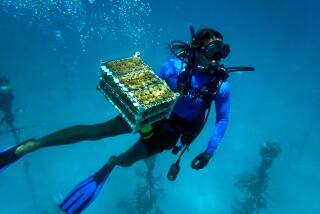Crocodiles making a comeback in south Florida
BOCA RATON, Fla. â Paddling down the Intracoastal Waterway in southern Florida, Russell Fields noticed what appeared to be a large palm leaf floating near shore.
The leaf began moving toward him. A few feet from his paddleboard, a reptilian head filled with teeth emerged from the water. Fields slapped the water with his paddle, and the head stayed there for a moment and then submerged.
Fieldsâ encounter with a 10-foot American crocodile in Boca Raton has become a more common experience in Broward and Palm Beach counties, as these light gray cousins of alligators reclaim their historic range. Crocodile numbers have risen from a low of 200 or so in the 1970s to about 2,000 today, with more of them roaming north from their core nesting areas in southern Everglades National Park and the Upper Florida Keys.
There have been no documented attacks on people in south Florida, the only part of the United States with crocodiles, although biologists wonât rule out the possibility.
The species can reach a length of 13 feet â as big as a large alligator â and the crocs have killed people on rare occasions in Mexico, Central America and the Caribbean. Although crocodile complaints have gone up, the Florida Fish and Wildlife Conservation Commission considers the animals little threat to the public and will relocate them only under certain circumstances.
âWeâre perfectly happy for a crocodile to be wherever they want to be,â said Lindsey Hord, coordinator of the nuisance alligator and crocodile program for the wildlife commission. âThe fact that thereâs a crocodile in central Broward County is cool, and weâre happy theyâre reoccupying their historic range. We donât act unless we receive a complaint.â
How can you tell youâre looking at a crocodile rather than an alligator? They are light gray, as opposed to blackish. They have narrower snouts, with a fourth tooth that protrudes from the lower jaw, adding an extra touch of menace to an already forbidding appearance. Unlike alligators, which live in fresh water, they prefer brackish, coastal waters.
During a helicopter search for manatees this winter, biologists for Broward County spotted a nine-foot crocodile basking on the banks of the Dania Cut-Off Canal, just across from Port Everglades. On their next search a week later, they spotted one â possibly the same crocodile â swimming down the North Fork of the New River, just south of the Swap Shop flea market.
âWe were really excited to see them,â said Ryan Goldman, a natural resource specialist with Broward Countyâs Environmental Protection and Growth Management Dept.
On a waterway just off the Intracoastal in southern Hollywood, Maureen Shanley saw one estimated to be at least 10 feet long.
âWe thought it was a log at first, but it was moving,â she said.
The crocodile rested its snout on the bank and later crawled up on a sea wall.
âIt wasnât bothering anyone, but people need to be aware that theyâre out there,â she said. âWe did have a family of ducks that were coming around, then we saw the croc and all of a sudden there are a couple missing.â
Crocodiles typically eat fish, blue crabs and an occasional shorebird. South Florida probably never supported more than a few thousand crocodiles, even before they lost a lot of territory to urban development, said Frank Mazzotti, professor of wildlife ecology at the University of Florida.
The species recovered through the protection of habitat at Everglades National Park and Biscayne National Park, and through creation of additional habitat with canals and coastal spoil areas at the Crocodile Lake National Wildlife Refuge, established in 1980, and the Turkey Point nuclear power plant, where the cooling canals turned out to be excellent nesting spots.
âWeâve protected their habitat,â Mazzotti said. âThereâs no secret. You protect habitat, youâll recover endangered species. It really is that simple.â
Complaints from the public about crocodiles totaled 183 in 2013, up from 118 in 2007. The wildlife agency cautions against reading too much into the numbers beyond a broad upward trend, since one crocodile might have yielded multiple complaints. Last year, a crocodile snatched a 65-pound dog off a sea wall in Key Largo, an attack that biologists said was highly unusual.
Unlike alligators, crocodiles are protected as a threatened species under the Endangered Species Act, which means the wildlife commission canât simply call in trappers to kill them in response to complaints. The commission can arrange for the crocodile to be relocated, but only under certain circumstances involving its size, location and behavior.
Still, many people enjoy having crocodiles on their property. One Keys neighborhood held a memorial for a crocodile that had been killed. In another, a crocodile shows up at docks and seems to enjoy being watered with hoses.
More to Read
Sign up for Essential California
The most important California stories and recommendations in your inbox every morning.
You may occasionally receive promotional content from the Los Angeles Times.










